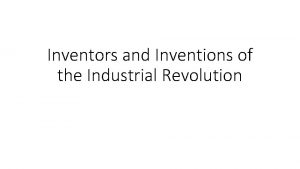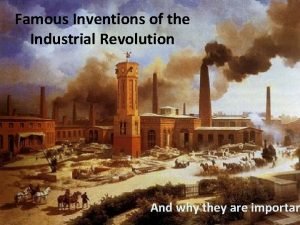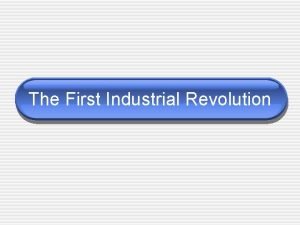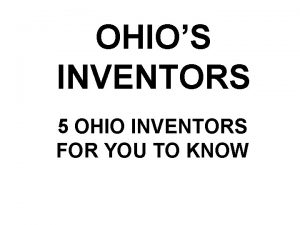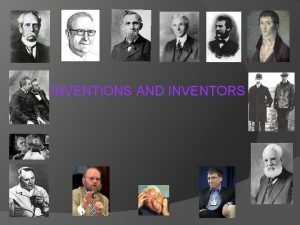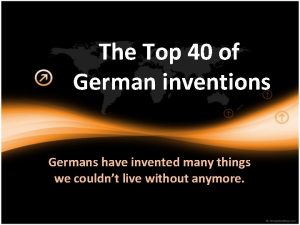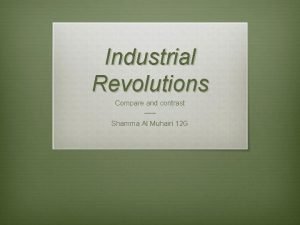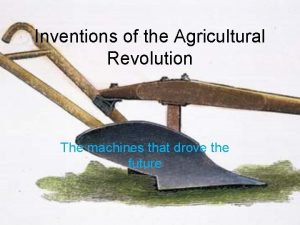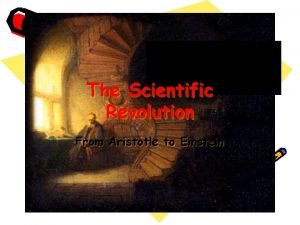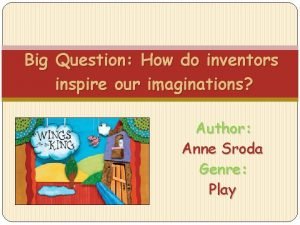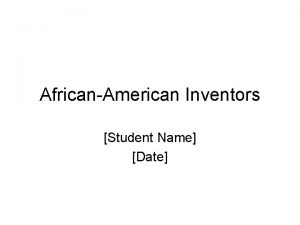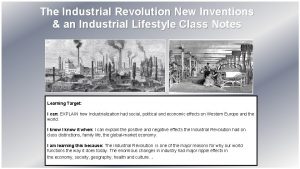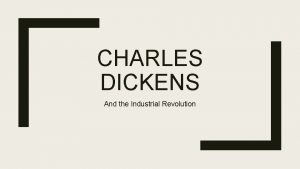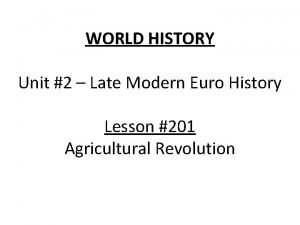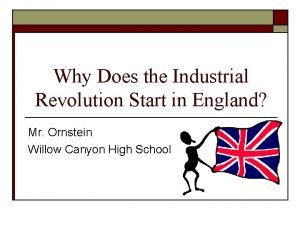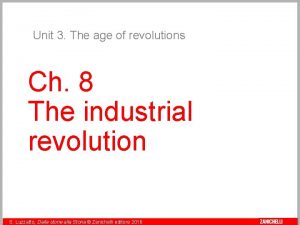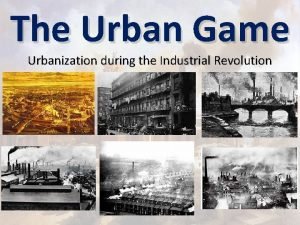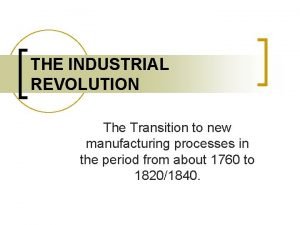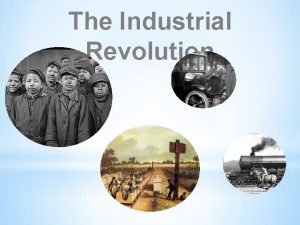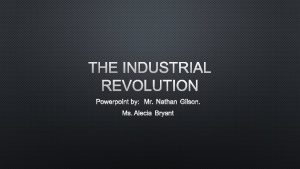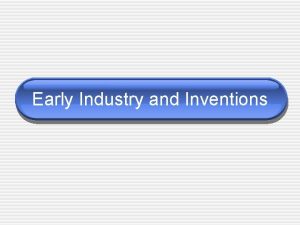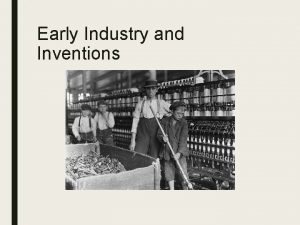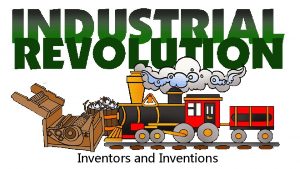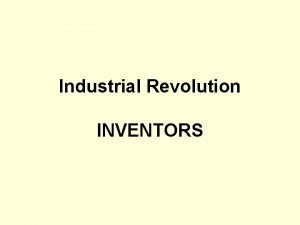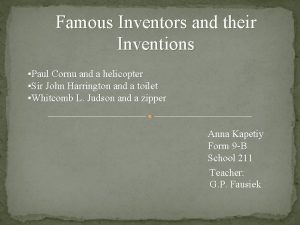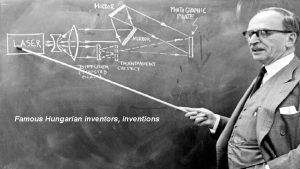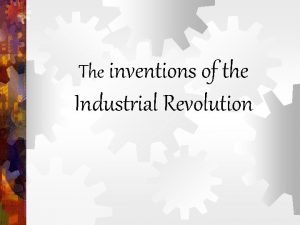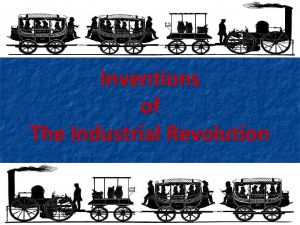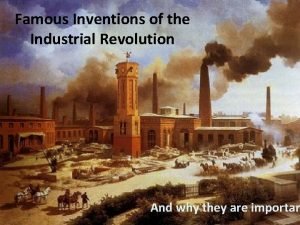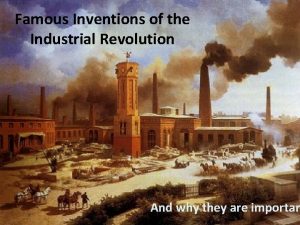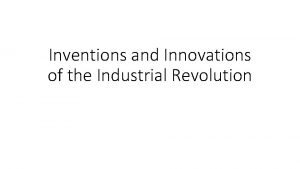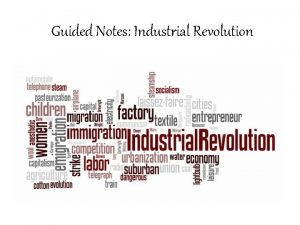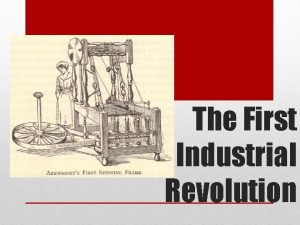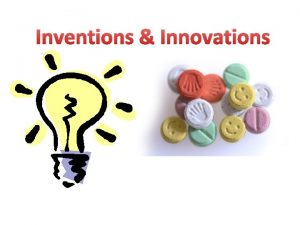The First Industrial Revolution Inventors and Famous Inventions





























- Slides: 29

The First Industrial Revolution

Inventors and Famous Inventions

Industrial Revolution • I. Origins A. Began in England in mid 1700’s B. Started in America in early 1800’s C. Transition from farming to manufacturing

Industrial Revolution II. The Factory System A. New technology 1. Workers and machinery brought together 2. Required a lot of money

Industrial Revolution B. Capitalists 1. Provided money for factories 2. Profited from investments

Spinning Jenny and Power Loom • Before the Industrial • • Revolution, clothes were made at home. Afterwards, clothes were made by machines in factories. Often these machines were run by children.

Factory System • The factory system had many workers • • under one roof working at machines. Many people left farms and moved to the city to work in factories. They wanted the money that factories paid. This change was not always for the better.

Factories Come to New England • New England was a • good place to have a factory. Factories needed water power, and New England had many fast-moving rivers.


Important People III. Important People A. Samuel Slater 1. Came to U. S. from England in 1789 2. Memorized plans for a textile mill 3. Opened first mill in North in 1790

Important People B. Francis Cabot Lowell 1. Improved design of textile mill 2. Boston Associates created Lowell, MA in 1821 3. Most workers were women & children a. Worked for less money than men b. Long days, dangerous conditions

The Lowell Girls • Young women came to • • Lowell in spite of the noise. They came for the good wages: between two and four dollars a week. The girls usually only worked for a few years until they married.

Less Dependency on Europe * As a result, the U. S. no longer had to buy finished textile products from Europe! View the inside of a 19 th century textile mill. (Lowell, MA ) 1845 Lowell factory pamphlet

Interchangeable Parts • The first use of interchangeable parts was • • created by inventor Eli Whitney. Before this time, guns were made one at a time. Each gun was different. If a part broke, a new part had to be created. Whitney created muskets with exactly the same parts, so any part would fit any gun. The use of interchangeable parts speeded up production, made repairs easier, and allowed the use of lower-paid, less skilled workers.


Important People C. Eli Whitney 1. Interchangeable parts 2. Cotton Gin (1793) a. Removed seeds from cotton b. Led to increase in slavery in the South

Factory Workers • Women were paid half as much as men. • Working hours were long, and wages were low. Ex. ) 12 -15 hour work days Earnings: men - $5 per week women - $2 per week children - $1 per week • Cities developed as farmers and immigrants took available factory jobs.

Transportation IV. Transportation A. Roads 1. Corduroy roads, turnpikes 2. Cumberland Road--First road built by the Federal government

Canals • Man made waterways were constructed all over the Northeast to get goods to west and east. • One canal that was built between the years 1817 -1825 was the Erie Canal.

New York and Canals • The Erie Canal ("Clinton's Big Ditch") opened on October • • • 26, 1825, 363 miles long, forty feet wide, four feet deep, 18 aqueducts and 83 locks, shortened travel time form the east coast to the gateway to the west (the Great Lakes) by half and reduced shipping costs by 90%. only trade route west of the Appalachians, prompted the first great westward migration of American settlers, turned Rochester into the nation's first boom town and made New York City the busiest port in the United States.

Transportation B. Canals 1. Erie Canal (1817 -1825) 2. New York--De. Witt Clinton

Steamboat • Robert Fulton designed • a steam engine for a steamboat that could move against the current of a river or against the wind. The steamboat created more opportunities for trade and transportation on rivers. His ship the Clermont sailed from New York City to Albany and back in 62 hours. A record at that time.

Transportation C. Steamboats 1. Robert Fulton—first commercial steamboat 2. Cleremont sailed on Hudson River in 1807

The Telegraph • The telegraph was • • • invented by Samuel Morse. This machine sent long and short pulses of electricity along a wire. With the telegraph, it took only seconds to communicate with another city. The invention of the steamboat and telegraph brought the people of the nation closer to each other. M o r s e C o d e

John Deere and the plow • In 1836, John Deere • invented a lightweight plow with a steel cutting edge. Deere’s plow made preparing the ground for planting much less work.

Cyrus Mc. Cormick and the reaper • Cyrus Mc. Cormick • invented a mechanical reaper, cut grain from the fields. This allowed farmers to plant much more seed because they could harvest it easier.

The Threshing Machine • The threshing • machine separated the kernels of wheat from the husks, which was a far faster way of getting wheat than picking it by hand. The threshing machine increased the growing of wheat.

The cotton gin • Inventory Eli Whitney also • • invented the cotton gin. The gin took the seeds out of the cotton, which was much faster than doing it by hand. The cotton gin also greatly expanded the need for slaves.

New Technologies help nation grow • With new farm equipment, Midwestern • • • farmers grew food to feed Northeastern factory workers. Midwestern farmers became a market for Northeastern manufactured goods. The growth of the textile factories increased the demand for Southern cotton. This led to the expansion of slavery.
 Key inventions of the industrial revolution
Key inventions of the industrial revolution Famous inventions of the industrial revolution
Famous inventions of the industrial revolution Interchangeable parts
Interchangeable parts Things that were invented in ohio
Things that were invented in ohio Famous asian inventors
Famous asian inventors Industrial revolution
Industrial revolution Henry ford famous inventions
Henry ford famous inventions Great german inventions
Great german inventions Shamma al muhairi
Shamma al muhairi Agricultural revolution inventions
Agricultural revolution inventions Newton's first law of motion
Newton's first law of motion How do inventors inspire our imaginations
How do inventors inspire our imaginations John logie bard
John logie bard Inventors
Inventors Africanamerican inventors
Africanamerican inventors Industrial revolution positive and negative effects
Industrial revolution positive and negative effects Dickens industrial revolution
Dickens industrial revolution Industrial revolution and social darwinism
Industrial revolution and social darwinism Russian revolution vs french revolution
Russian revolution vs french revolution How could the french revolution have been avoided
How could the french revolution have been avoided Green revolution vs third agricultural revolution
Green revolution vs third agricultural revolution Enclosure movement
Enclosure movement Why did the industrial revolution start in britain
Why did the industrial revolution start in britain The industrial revolution zanichelli
The industrial revolution zanichelli Industrial and urban game
Industrial and urban game Enclosure movement industrial revolution
Enclosure movement industrial revolution When was the loom invented
When was the loom invented The transition to new manufacturing processes
The transition to new manufacturing processes Industrial revolution quiz
Industrial revolution quiz Nathan gilson
Nathan gilson
